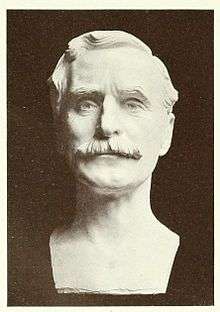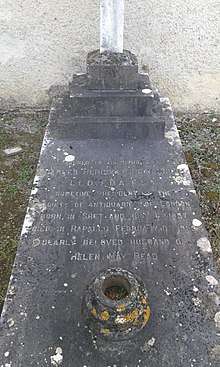Charles Hercules Read
Sir Charles Hercules Read, FBA FSA (6 July 1857 – 11 February 1929) was a British archaeologist and curator who became Keeper of British and Mediaeval Antiquities and Ethnography at the British Museum, and President of the London Society of Antiquaries, following his mentor Augustus Wollaston Franks in the first position in 1896, and in the second from 1908–14 and again in 1919, after being Secretary since 1892. He began periods as President of the Royal Anthropological Institute of Great Britain and Ireland in 1899 and 1917. He was knighted in 1912 and retired from the British Museum in 1921.[1] He usually dropped the "Charles" in his name, especially after he was knighted, though not consistently. "A man of handsome and even striking appearance",[2] he was a major figure in British museum curation in his day, though he published relatively little.

Career
Read was privately educated, with no university degree before he received an honorary doctorate from the University of Edinburgh in 1908. His first museum job was as secretary to a senior curator at the South Kensington Museum, now the Victoria and Albert Museum, where he came to know Franks. Franks then used him to work on the registration of the important collection of Ice Age art, ethnography and other objects of Henry Christy, which were then kept in a flat in Victoria Street, and of which Franks was a trustee. Much of the collection ended up in the British Museum under the terms of Christy's will. In 1880 he joined the British Museum itself as Franks' assistant, marrying the same year.[3]
As Keeper he was responsible for beginning the publication of catalogues, guides, books and booklets that brought awareness of the collections to a wider public. He employed the Oxford graduate Thomas Athol Joyce as an assistant in 1903.[4] In his time the department of "British and Medieval Antiquities and Ethnography" still included areas that were later split off, such as ethnography and "oriental" collections beyond Egypt and the Near East, as well as others not obviously covered by its title, including Western ceramics and glass of all dates, and post-medieval European objects. At his retirement this sprawling empire began to be divided.[5] Read was notable for his knowledge across this vast range, rather than being a specialist in particular areas. Like Franks, he was popular with major collectors, helping to steer several significant donations to the museum, from J. Pierpont Morgan among others.[6]
A rare excursion into archaeological excavation was his supervision of the excavation of the royal Anglo-Saxon cemetery at Highdown Hill in Sussex in the 1890s, which even by the standards of that date was not a model of best practice. One unfortunate episode was his advice to the Ashmolean Museum in Oxford to decline the loan of the Anglo-Saxon Fuller Brooch, which he wrongly believed to be a modern fake; after his day it was bought by the British Museum.[7]
Death

His health was bad after his retirement, and he spent the winters on the Riviera, dying in Rapallo, Italy on 11 February 1929.[8] He was buried in the Cimitero Urbano.
Publications
(selected)
- Read, Charles Hercules, & Dalton, Ormonde Maddock (1899). Antiquities from the city of Benin and from other parts of West Africa in the British Museum. London: British Museum. External link in
|title=(help)CS1 maint: multiple names: authors list (link) - The Waddesdon Bequest: Catalogue of the Works of Art bequeathed to the British Museum by Baron Ferdinand Rothschild, M.P., 1898, 1902, British Museum, Fully available on the Internet archive The catalogue numbers here are still used, and may be searched for on the BM website as "WB.1" etc.
- The Royal Gold Cup of the Kings of France and England, now preserved in the British Museum. Vetusta Monumenta Volume 7, part 3, 1904, the first publication of the Royal Gold Cup
Notes
- Balfour, 61
- Balfour, 61
- Balfour, 61; Tonnochy, 84–85; Burlington, 153
- Raymond John Howgego, 'Joyce, Thomas Athol (1878–1942)', Oxford Dictionary of National Biography, Oxford University Press, May 2010 accessed 1 Dec 2013
- Tonnochy, 83, 86
- Balfour, 61; Tonnochy, 85; Burlington, 153–154
- David Mackenzie Wilson (1964), Catalogue of antiquities of the later Saxon period, British Museum, OCLC 610435306,
The brooch's history (as recounted by Bruce-Mitford) is that it was bought from a London bric-à-brac dealer by an unnamed man who did not know its history, he passed it to Sir Charles Robinson who published it in 'The Antiquary'. A few years later Mr. E. Hockliffe, the son-in-law of Sir Charles Robinson, offered the brooch as a loan to the Ashmolean Museum, Oxford. E. T. Leeds, then an assistant at the museum, persuaded the then keeper D. G. Hogarth to accept the loan. On the advice of the then Keeper of British and Medieval Antiquities at the British Museum (Sir Hercules Read, P.S.A.) and his assistant keeper (R. A. Smith) the brooch was pronounced a fake and withdrawn from exhibition with the approval of the Ashmolean Museum's technical specialist, W. H. Young. The brooch was eventually purchased by Capt. A. W. F. Fuller and, apart from occasional mentions (e.g. by Sir Alfred Clapham), was not thought of seriously until the Strickland brooch (registration no. 1949,0702.1) was brought to the British Museum. On the advice of Sir Thomas Kendrick the Fuller brooch was traced by Mr. Bruce-Mitford and after laboratory examination it was acquired by the British Museum.
- Tonnochy, 86
References
- "Burlington": Sir Hercules Read, The Burlington Magazine (no author given), Vol. 54, No. 312 (Mar. 1929), pp. 153–154, JSTOR
- Balfour, Henry, Obituary Sir Charles Hercules Read, 6 July 1857 – 11 February 1929, Man (Royal Anthropological Institute of Great Britain and Ireland), Vol. 29, (Apr. 1929), pp. 61–62, JSTOR
- Tonnochy, A. B., Four Keepers of the Department of British and Medieval Antiquities, The British Museum Quarterly, Vol. 18, No. 3 (Sep. 1953), pp. 83–88, JSTOR